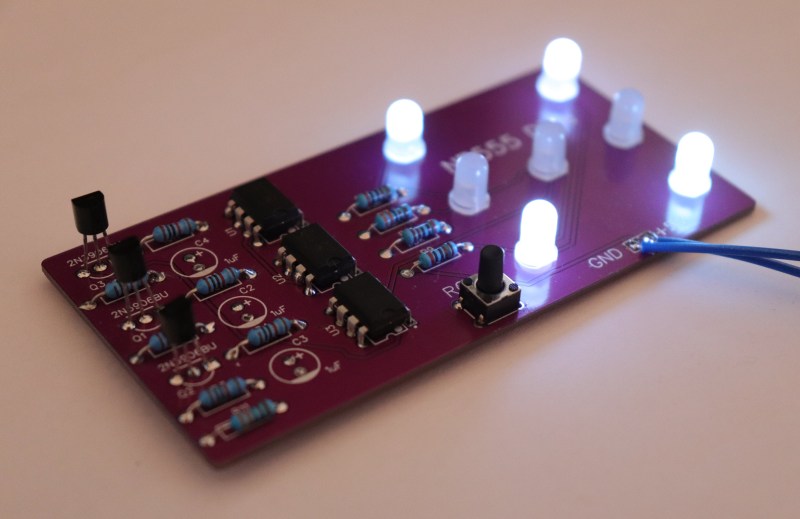It has become a bit of a running joke in the Hackaday community to suggest that a project could or should have been done with a 555 timer. [Tim] has rather taken this to heart with his latest Electronic Dice project, which uses three of the venerable devices.
If three seems like a lot of 555s to make an electronic die, then it may be worth considering that the last time we shared his project he was using 22 of them! Since then, [Tim] has been busy optimising his design, whilst keeping within the constraints of an old-school through-hole soldering kit.
Maybe the most surprising thing about this project is the purpose to which the NE555 devices are pressed. Rather than using them for their famous oscillation properties, they are in actual fact just being used as Schmitt Triggers to clean up the three-phase ring oscillator that is constructed from discrete transistors and passives.

The ring oscillator cleverly produces three phase-shifted square waves such that a binary combination of the three phases offers six unique states. Six being the perfect number for a dice throw, all that then remains is to figure out which LEDs need to be switched on in which state and wire them up accordingly.
To “roll” the dice, a push-button powers up the oscillator, and stops it again when it is released, displaying the random end-state on the LEDs.
It can be fun to see what can be done using old technology, and educational to try to optimise a design down to the fewest parts possible.
[Tim]’s earlier project is here if you want to see how the design has evolved. The documentation on both of these iterations is excellent and well worth a read.
















That’s old news, pre-Ukraine invasion era :-P
I made a quick 555 based adjustable on-off boost converter with a FET and a few other components I found. Keeps a small 12V lead acid battery topped up from USB 5V input.
Srsly? I saw electronic dices like that in 1990s “Elektronika dla Wszystkich” magazine. That’s not old news, that’s like buying a 1991 BMW E34, taking foams from driver seat and using their essence to make beer. Even if it looks like beer and tastes like beer it would be hard to call it a 1991 vintage beer.
He should have used a 556 to reduce chip count…
8-)
Or the rarely heard-of, little-used, oft-neglected 558 quad timer. Shrink to one chip!
It’s maybe not immediately obvious from the article, but this is an attempt to make an electronic dice with as few discrete components as possible. This does not really depend on the age of the components – a Schmitt trigger is a Schmitt trigger even in “5 nm”.
So, can you optimize the circuit even more?
Probably ATmega 8 or PIC16 could do the same thing in one chip, depends on program size and GPIO needed.
I could do it with an ATTiny85 and charlieplexing.
There should be some penalty for using ICs, because you could use a CD4017 to replace the ring oscillator and the schmitt-triggers with a single counter IC.
Like everyone knows, the analog variety of dice offers a richer midrange, warmer experience and more open sound stage. All that gets lost when you go digital.
Arguably the analog circuit is more like a real dice in that the ring oscillator isn’t perfectly balanced. It’s like a real die which is always unbalanced to some extent.
Outside world – “There’s an app for that”
Hackaday World – “There’s a 555 for that”
I’ll have to dig this high school project back out that I did back in 2009
Why use a microcontroller when a few 555 timers will do